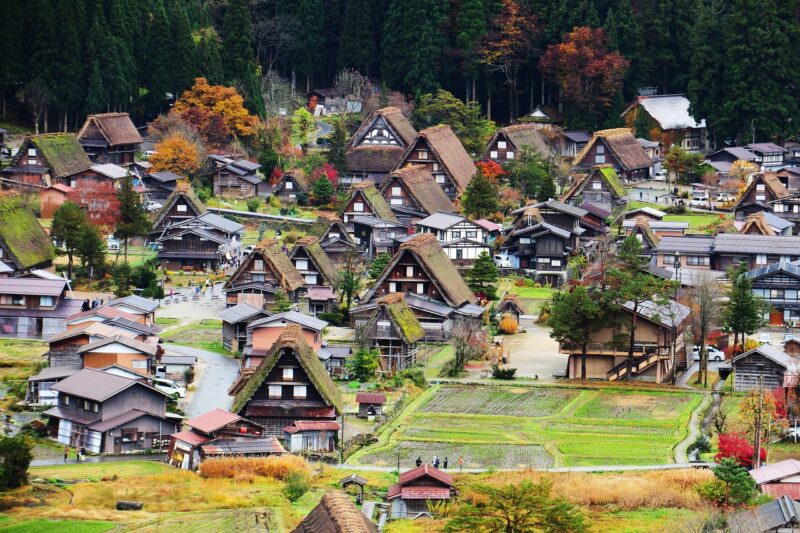Japan’s Remote and Serene Getaways: Japan, a land of ancient traditions and modern marvels, captivates visitors with its diverse landscapes, rich history, and unique cultural experiences. While bustling cities like Tokyo and Kyoto often take the spotlight, Japan is also home to hidden gems and remote and serene getaways that offer a tranquil escape from the urban hustle. In this article, we’ll embark on a journey to discover these lesser-known destinations and the experiences they offer.
Table of Content
- Japan’s Remote Getaways
- Serene Getaways in Japan
- Kyoto: Traditional Charm and Temples
- Nara: Ancient Capital and Friendly Deer
- Kanazawa: Historic Districts and Traditional Crafts
- Takayama: Quaint Atmosphere and Festivals
- Ise-Shima: Sacred Shrines and Coastal Beauty
- Unique Accommodation Options
- Ryokans: Traditional Japanese Inns
- Capsule Hotels: Compact and Affordable
- Temple Stays: Spiritual Retreats
- Machiya: Traditional Townhouses
- Minshuku: Homey Guesthouses
- Experiencing Japanese Cuisine
- Savoring Sushi: Freshness and Artistry
- Ramen: Noodle Delights
- Izakaya: Casual Dining and Drinking
- Kaiseki: Fine Dining and Seasonal Flavors
- Street Food: Tantalizing Snacks
- Transportation and Travel Tips
- Efficient Rail Network: Shinkansen and Local Trains
- Public Transportation: Buses and Subways
- Japan Rail Pass: Cost-effective Travel
- Etiquette and Customs: Respect and Politeness
- Language Considerations: Basic Phrases and Translation Apps
- Conclusion
- FAQs
Japan’s Remote Getaways
Hokkaido: Exploring Nature’s Paradise
Nestled in the northernmost part of Japan, Hokkaido boasts breathtaking natural beauty and vast expanses of untouched wilderness. From the snow-covered peaks of the Daisetsuzan Mountains to the crystal-clear lakes of Shiretoko National Park, nature enthusiasts will find themselves in awe of the serene landscapes. Hokkaido is also renowned for its hot springs, where visitors can relax and rejuvenate in mineral-rich waters while surrounded by snow-capped mountains.
Okinawa: Tropical Retreats and Pristine Beaches
Located in the southernmost part of Japan, the Okinawa archipelago offers a tropical paradise with its turquoise waters, white sandy beaches, and vibrant coral reefs. The islands are perfect for beach lovers, snorkelers, and scuba diving enthusiasts. Okinawa’s unique blend of Japanese and Ryukyuan culture adds a distinctive charm to the region, with traditional music, dance, and crafts to explore.
Tohoku: Rich Culture and Tranquil Landscapes
Tohoku, in the northeastern part of Japan’s main island, is a region blessed with breathtaking landscapes and rich cultural heritage. Aomori’s Nebuta Festival, held in summer, mesmerizes spectators with its gigantic illuminated floats, while Sendai’s Tanabata Festival celebrates the meeting of star-crossed lovers with colorful decorations. Tohoku is also home to tranquil spots such as Matsushima Bay, known for its picturesque islands and serene atmosphere.
Shikoku: Pilgrimages and Scenic Beauty
Shikoku, Japan’s fourth-largest island, offers a blend of spiritual pilgrimages and captivating natural beauty. The 88 Temple Pilgrimage, a sacred Buddhist route, takes visitors on a transformative journey through serene mountains, ancient temples, and quaint villages. The island’s lush landscapes, including the stunning Iya Valley and the Naruto Whirlpools, provide opportunities for hiking, river rafting, and immersing oneself in nature.
Kyushu: Hot Springs and Volcanic Wonders
Kyushu, the southwesternmost of Japan’s main islands, is a geothermal paradise dotted with hot springs, volcanoes, and scenic wonders. Beppu, known as the “Onsen Capital of Japan,” offers a wide range of hot spring experiences, from traditional bathhouses to unique sand baths. Mount Aso, one of the world’s largest volcanic calderas, provides breathtaking views and opportunities for hiking and exploring.
Serene Getaways in Japan
Kyoto: Traditional Charm and Temples
As the cultural heart of Japan, Kyoto enthralls visitors with its rich history, traditional architecture, and enchanting temples. The iconic Fushimi Inari Taisha welcomes visitors with its vibrant torii gates, while Kinkaku-ji, the Golden Pavilion, shimmers in all its glory. Exploring Kyoto’s serene bamboo groves and tranquil gardens, such as the renowned Arashiyama and Ginkaku-ji, offers moments of peace and contemplation.
Nara: Ancient Capital and Friendly Deer
A short distance from Kyoto, Nara captivates with its ancient temples, deer-filled parks, and a deep sense of history. The awe-inspiring Todai-ji Temple houses the Great Buddha, a massive bronze statue that leaves visitors in awe of its craftsmanship. Roaming freely around Nara Park, the friendly deer add a unique charm to the city, making it a delightful destination for animal lovers and history enthusiasts alike.
Kanazawa: Historic Districts and Traditional Crafts
Kanazawa, located on the west coast of Japan, is a city renowned for its well-preserved historic districts and traditional arts and crafts. The Kenrokuen Garden, one of Japan’s most beautiful gardens, showcases stunning landscapes that change with the seasons. Kanazawa Castle, Nagamachi Samurai District, and the Higashi Chaya District offer glimpses into the city’s rich samurai and geisha heritage.
Takayama: Quaint Atmosphere and Festivals
Nestled in the Japanese Alps, Takayama is a charming town known for its well-preserved Edo-era streets, traditional wooden houses, and vibrant festivals. The Takayama Festival, held in spring and autumn, features ornate floats and lively processions that illuminate the streets. Visitors can also explore the Hida Folk Village, a picturesque open-air museum showcasing traditional thatched-roof houses.
Ise-Shima: Sacred Shrines and Coastal Beauty
Situated along the picturesque coastline of Mie Prefecture, Ise-Shima entices visitors with its spiritual aura and stunning natural scenery. The Ise Grand Shrine, one of Japan’s most sacred Shinto sites, is a place of pilgrimage and reverence. The region’s coastal beauty is exemplified by the rugged cliffs of the Shima Peninsula and the tranquil waters of Ago Bay, where visitors can enjoy fishing, cruising, and pearl diving.
Unique Accommodation Options
Ryokans: Traditional Japanese Inns
One of the best ways to experience Japanese hospitality and immerse oneself in traditional culture is by staying in a ryokan. These traditional Japanese inns offer tatami-matted rooms, futon beds, communal baths, and exquisite kaiseki meals. Guests can relax in yukata robes, sip green tea, and indulge in the tranquil atmosphere of these serene retreats.
Capsule Hotels: Compact and Affordable
For budget-conscious travelers seeking a unique experience, capsule hotels provide compact and affordable accommodations. These capsule-like pods offer a cozy space with a bed, storage, and basic amenities. Despite their small size, capsule hotels often provide communal spaces, such as lounges and communal baths, where guests can socialize and unwind.
Temple Stays: Spiritual Retreats
Immerse yourself in the serenity of Japanese temples by participating in a temple stay. This cultural experience allows visitors to engage in Zen meditation, experience traditional Buddhist rituals, and dine on vegetarian meals. Temple stays offer a chance to disconnect from the hustle and bustle of daily life and find inner peace in a tranquil setting.
Machiya: Traditional Townhouses
In Kyoto and other historic cities, machiya townhouses offer a glimpse into traditional Japanese architecture and lifestyle. These beautifully preserved wooden houses feature sliding doors, tatami mats, and peaceful inner gardens. Staying in a machiya provides an immersive experience, allowing guests to appreciate the intricate craftsmanship and cultural heritage of Japan.
Minshuku: Homey Guesthouses
Minshuku guesthouses offer a warm and welcoming environment where travelers can experience the hospitality of local Japanese families. With comfortable rooms, home-cooked meals, and personalized service, minshukus provide a homely atmosphere that makes guests feel like part of the family. These guesthouses are particularly popular in rural areas and coastal regions.
Experiencing Japanese Cuisine
Savoring Sushi: Freshness and Artistry
Japan’s culinary scene is incomplete without mentioning its most iconic dish, sushi. Whether enjoyed at high-end sushi restaurants or humble street stalls, sushi captivates with its freshness, delicate flavors, and meticulous presentation. From the beloved nigiri to creative rolls, experiencing sushi in Japan is a must for food enthusiasts.
Ramen: Noodle Delights
Ramen, a hearty and flavorful noodle soup, has gained worldwide popularity, but nothing compares to savoring a bowl of authentic ramen in Japan. Each region has its own unique style, such as Tokyo’s soy-based shoyu ramen, Sapporo’s rich miso ramen, and Fukuoka’s tonkotsu ramen with creamy pork bone broth. Slurping noodles and sipping savory broth is a culinary journey not to be missed.
Izakaya: Casual Dining and Drinking
For a lively and casual dining experience, izakayas are the perfect choice. These Japanese-style pubs offer an extensive menu of small, shareable dishes called izakaya-yaki, complemented by a wide selection of sake, shochu, and beer. From yakitori (grilled skewers) to tempura and sashimi, izakayas are ideal for enjoying good food, drinks, and the company of friends.
Kaiseki: Fine Dining and Seasonal Flavors
Kaiseki is the epitome of Japanese haute cuisine, characterized by meticulous preparation, seasonal ingredients, and artistic presentation. This multi-course meal showcases the culinary skills of the chef and reflects the changing seasons. Kaiseki dining is a harmonious experience that engages all the senses, allowing guests to appreciate the delicate flavors and aesthetic beauty of each dish.
Street Food: Tantalizing Snacks
Exploring Japan’s vibrant street food scene is an adventure in itself. From takoyaki (octopus balls) in Osaka to yakisoba (fried noodles) in Hiroshima and taiyaki (fish-shaped cakes) in Tokyo, street vendors offer an array of tantalizing snacks that satisfy cravings and introduce visitors to the local flavors of different regions. Strolling through bustling food markets and trying various street food delights is a culinary delight.
Transportation and Travel Tips
Efficient Rail Network: Shinkansen and Local Trains
Japan’s efficient and extensive rail network is the ideal way to explore the country’s remote getaways and serene destinations. The famous Shinkansen, or bullet train, provides high-speed connections between major cities, while local trains offer access to more remote areas. With comfortable seats, punctuality, and scenic routes, train travel in Japan is a delight for both locals and tourists.
Public Transportation: Buses and Subways
In cities and towns, public transportation systems, including buses and subways, offer convenient ways to navigate and explore. Japan’s reliable and well-connected bus network reaches even the most remote areas, while subways provide efficient transportation within urban centers. Travelers can obtain prepaid transportation cards, such as the Suica or Pasmo, for seamless and cashless travel on buses, subways, and trains.
Japan Rail Pass: Cost-effective Travel
For travelers planning to visit multiple destinations, the Japan Rail Pass is a cost-effective option. This special pass allows unlimited travel on JR trains, including the Shinkansen, for a fixed period. Available in various durations, the Japan Rail Pass provides flexibility and substantial savings, especially for long-distance journeys. It’s important to note that the pass must be purchased in advance and is only available to foreign visitors.
Etiquette and Customs: Respect and Politeness
Japanese culture places great emphasis on respect, politeness, and harmonious interactions. Travelers should familiarize themselves with basic etiquettes, such as bowing as a form of greeting, removing shoes in certain establishments, and using honorific language. Respecting local customs and cultural norms contributes to a positive and enriching travel experience in Japan.
Language Considerations: Basic Phrases and Translation Apps
While English is spoken to some extent in tourist areas, learning a few basic Japanese phrases can greatly enhance communication and interactions with locals. Phrases such as “hello” (konnichiwa), “thank you” (arigatou gozaimasu), and “excuse me” (sumimasen) go a long way in showing respect and creating a positive impression. Additionally, translation apps can be useful for overcoming language barriers and facilitating conversations with locals.
Conclusion Japan’s Remote and Serene Getaways
Japan’s remote and serene getaways offer a delightful escape from the bustling cities and a chance to immerse oneself in the country’s natural beauty, rich history, and unique cultural experiences. From Hokkaido’s untamed wilderness to Kyoto’s traditional charm, each destination captivates with its distinct allure. Whether indulging in local cuisine, staying in traditional inns, or exploring spiritual sites, these hidden gems provide unforgettable moments of tranquility and discovery.
Similar Articles to Japan’s Remote and Serene Getaways
FAQs Japan’s Remote and Serene Getaways
- How can I travel to Japan on a budget?
- Traveling to Japan on a budget is possible by opting for affordable accommodation options like capsule hotels and minshuku guesthouses. Utilizing the Japan Rail Pass for cost-effective transportation and exploring local street food can also help save money.
- Are English signs and instructions available in Japan?
- While English signs and instructions can be found in tourist areas and major cities, it’s helpful to learn basic Japanese phrases and use translation apps for smoother communication, especially in remote regions.
- What is the best time to visit Japan?
- The best time to visit Japan depends on personal preferences and the desired experiences. Spring (March to May) and autumn (September to November) are popular for pleasant weather, cherry blossoms, and vibrant foliage.
- Can I experience a traditional Japanese tea ceremony?
- Yes, traditional tea ceremonies can be experienced in tea houses and cultural centers in various cities, such as Kyoto and Tokyo. These ceremonies offer insights into the art of tea preparation and its significance in Japanese culture.
- What is the recommended duration for exploring Japan’s remote getaways?
- The duration for exploring Japan’s remote getaways depends on individual preferences and the desired depth of exploration. It’s recommended to allocate at least a few days to each destination to fully appreciate its beauty and immerse in its unique experiences.
- What is the currency used in Japan, and can I use credit cards?
- The currency used in Japan is the Japanese yen (JPY). While credit cards are widely accepted in major establishments and cities, it’s advisable to carry some cash, especially when visiting remote areas or smaller shops and restaurants.
- Is it necessary to tip in Japan?
- No, tipping is not customary in Japan. In fact, leaving a tip may be seen as rude or confusing. Exceptional service is already included in the price, and the Japanese hospitality known as “omotenashi” ensures that you receive excellent service without the need for tipping.
- What are some etiquette guidelines when visiting temples and shrines?
- When visiting temples and shrines in Japan, it’s important to show respect. Remove your hat, shoes, and sunglasses before entering certain areas. Be mindful of noise levels and avoid touching artifacts unless specifically allowed. Also, refrain from taking photographs where it is prohibited.
- Can I use my mobile phone in Japan?
- Yes, you can use your mobile phone in Japan, but it’s important to check with your service provider regarding international roaming charges. Alternatively, you can rent a portable Wi-Fi device or purchase a local SIM card for internet access during your stay.
- Are there any specific customs or rules to follow when using public transportation?
- When using public transportation in Japan, it’s important to queue in an orderly manner and let passengers exit before entering. Avoid talking on the phone or speaking loudly to maintain a quiet and respectful atmosphere. Priority seating is typically available for the elderly, disabled, and pregnant women.
- Are there any safety concerns for travelers in Japan?
- Japan is generally considered a safe country for travelers. However, it’s always advisable to take standard precautions such as securing your belongings, being aware of your surroundings, and following local laws and regulations. Emergency services, including police and medical assistance, are readily available if needed.
- Can I use public Wi-Fi in Japan?
- Yes, public Wi-Fi is available in certain areas of Japan, such as airports, train stations, and cafes. However, it’s recommended to have alternative means of internet access, such as renting a portable Wi-Fi device or using a SIM card, for more reliable connectivity throughout your travels.
- What are some traditional souvenirs or crafts to buy in Japan?
- Japan is known for its exquisite crafts and unique souvenirs. Popular choices include traditional ceramics like Japanese porcelain and pottery, beautiful handcrafted textiles such as kimono fabric and silk products, intricate wooden crafts like lacquerware and Kokeshi dolls, and traditional tea sets and matcha tea.
- Can I visit Mount Fuji during my trip to Japan?
- Yes, Mount Fuji is a popular destination for tourists. The climbing season typically runs from July to early September, and there are various trails to choose from based on your hiking experience and preferences. Additionally, you can enjoy stunning views of Mount Fuji from nearby locations such as Lake Kawaguchi and Hakone.
- Is it necessary to get travel insurance when visiting Japan?
- While travel insurance is not a mandatory requirement for visiting Japan, it is highly recommended. Travel insurance provides coverage for medical emergencies, trip cancellations, lost baggage, and other unforeseen events, ensuring peace of mind during your travels.
Remember to always check the latest travel advisories and guidelines from your home country’s government and follow any specific requirements or regulations set by Japanese authorities for a safe and enjoyable trip to Japan.
Japan’s Remote and Serene Getaways









